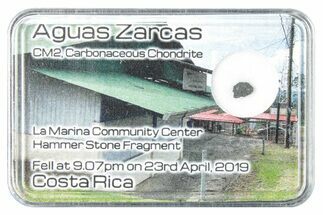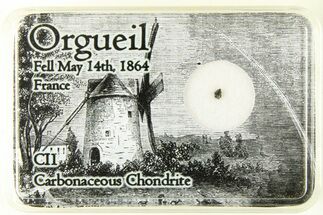.07" Murchison Chondrite Meteorite Fragment - Australia
This is an incredibly rare specimen: a .07" wide fragment of the Murchison meteorite of Australia! It comes in a bespoke display case.
Murchison is among the more famous chondrites to fall in the last century, and one of the largest CM2 chondrites to fall on Earth. It made landfall near the town of Murchison in Victoria, Australia at about 11:00AM local time on September 28, 1969, and was soon collected. Eventually about 100 kilograms of fragments were found in a strewn field covering about five square miles: some had even punched holes through the roof of a barn! Because of its abundant mass and witnessed fall, Murchison has been a landmark specimen for meteorite research.
Like other members of the CM2 carbonaceous chondrite group, Murchison has some highly unusual features worthy of decades of study. Firstly, Murchison is old: silicon carbides and other presolar grains contained within it have been dated to about 7 billion years old. That's almost 3 billion years older than our own solar system! It is also about 8 percent water, owing to its many hydrated minerals found throughout. Murchison is also unusual for its abundance of organic compounds such as amino acids, as well as volatile compounds and hydrocarbons that give specimens a faintly earthy or even alcoholic scent. To date, over 70 amino acids have been identified from this meteorite, only 19 of which are found on Earth! Scientists are still publishing papers today about the chemical mysteries this meteorite contains.
Murchison shares a similar look to most other CM2 chondrites. It contains varied whitish to gray clasts and rounded chondrules within a dark gray to black matrix. Occasionally, irregular-shaped pockets of calcium-aluminum rich inclusions (CAIs) may also be found.
Like other members of the CM2 carbonaceous chondrite group, Murchison has some highly unusual features worthy of decades of study. Firstly, Murchison is old: silicon carbides and other presolar grains contained within it have been dated to about 7 billion years old. That's almost 3 billion years older than our own solar system! It is also about 8 percent water, owing to its many hydrated minerals found throughout. Murchison is also unusual for its abundance of organic compounds such as amino acids, as well as volatile compounds and hydrocarbons that give specimens a faintly earthy or even alcoholic scent. To date, over 70 amino acids have been identified from this meteorite, only 19 of which are found on Earth! Scientists are still publishing papers today about the chemical mysteries this meteorite contains.
Murchison shares a similar look to most other CM2 chondrites. It contains varied whitish to gray clasts and rounded chondrules within a dark gray to black matrix. Occasionally, irregular-shaped pockets of calcium-aluminum rich inclusions (CAIs) may also be found.
About Chondrites
A chondrite is a stony (non-metallic) meteorite that has not been modified by either melting or differentiation of the parent body. Chondrites are formed when various types of dust and small grains in the early Solar System accreted to form primitive asteroids. Some such bodies are captured in the planet’s gravity well and pulled to the surface. They are by far the most common type of meteorite, representing about 86 percent of all meteorites that have fallen to Earth.
Prominent among the components present in chondrites are the enigmatic chondrules, millimeter-sized spherical objects that originated as freely floating, molten or partially molten droplets in space; most chondrules are rich in the silicate minerals olivine and pyroxene. Chondrites also contain particles of various metals such as nickel, iron, and aluminum. These formed at the very beginning of the solar system and aggregated over time: they are the oldest rocks known on Earth!
Chondrites are divided into about fifteen distinct groups on the basis of their mineralogy, bulk chemical composition, and oxygen isotope compositions. The various chondrite groups likely originated on separate asteroids or groups of related asteroids. Each chondrite group has a distinctive mixture of chondrules, refractory inclusions, matrix (dust), characteristic chondrule sizes, and other components. Other ways of classifying chondrites include weathering and shock. The L chondrite group is the most common of these.
A chondrite is a stony (non-metallic) meteorite that has not been modified by either melting or differentiation of the parent body. Chondrites are formed when various types of dust and small grains in the early Solar System accreted to form primitive asteroids. Some such bodies are captured in the planet’s gravity well and pulled to the surface. They are by far the most common type of meteorite, representing about 86 percent of all meteorites that have fallen to Earth.
Prominent among the components present in chondrites are the enigmatic chondrules, millimeter-sized spherical objects that originated as freely floating, molten or partially molten droplets in space; most chondrules are rich in the silicate minerals olivine and pyroxene. Chondrites also contain particles of various metals such as nickel, iron, and aluminum. These formed at the very beginning of the solar system and aggregated over time: they are the oldest rocks known on Earth!
Chondrites are divided into about fifteen distinct groups on the basis of their mineralogy, bulk chemical composition, and oxygen isotope compositions. The various chondrite groups likely originated on separate asteroids or groups of related asteroids. Each chondrite group has a distinctive mixture of chondrules, refractory inclusions, matrix (dust), characteristic chondrule sizes, and other components. Other ways of classifying chondrites include weathering and shock. The L chondrite group is the most common of these.
TYPE
Carbonaceous Chondrite (CM2)
LOCATION
Murchison, Victoria, Australia
SIZE
.07" wide
CATEGORY
ITEM
#286079
 Reviews
Reviews









